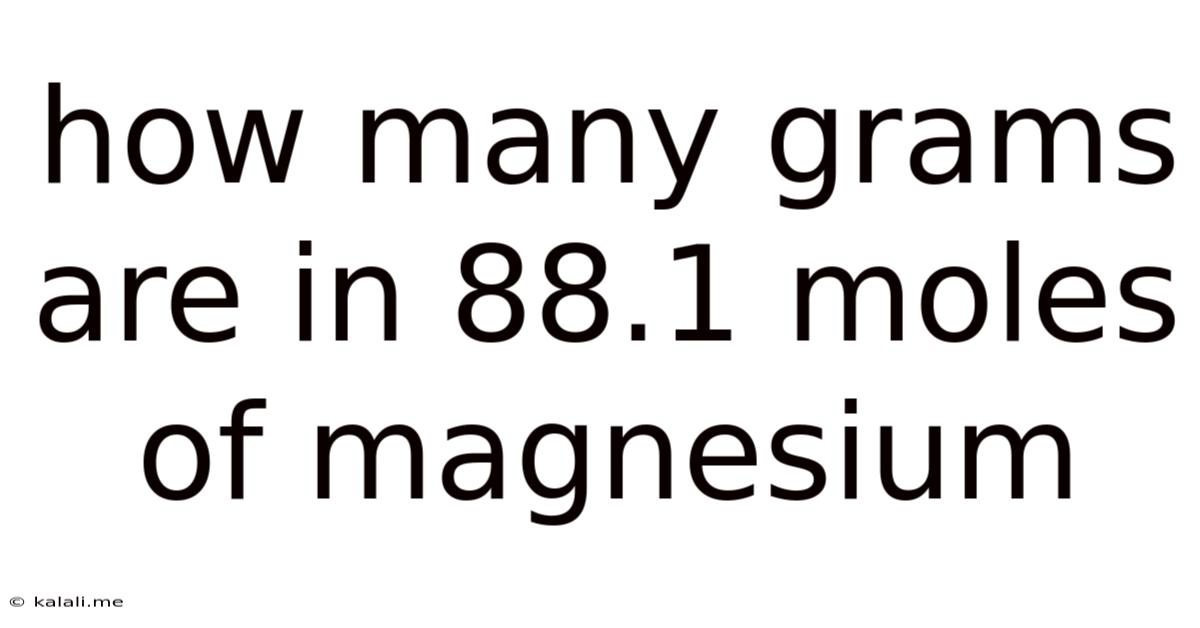How Many Grams Are In 88.1 Moles Of Magnesium
Kalali
Jul 07, 2025 · 4 min read

Table of Contents
How Many Grams Are in 88.1 Moles of Magnesium? A Deep Dive into Moles, Grams, and Avogadro's Number
This article will comprehensively answer the question: how many grams are in 88.1 moles of magnesium? We'll delve into the fundamental concepts of moles, molar mass, and Avogadro's number, providing a step-by-step calculation and exploring real-world applications of this type of conversion. Understanding these concepts is crucial in chemistry and related fields.
Understanding Moles: The Chemist's Counting Unit
In chemistry, we deal with incredibly large numbers of atoms and molecules. It's impractical to count them individually. That's where the mole (mol) comes in. A mole is a unit of measurement that represents a specific number of particles, just like a dozen represents 12 items. This specific number is Avogadro's number, approximately 6.022 x 10<sup>23</sup>. One mole of any substance contains Avogadro's number of particles (atoms, molecules, ions, etc.).
Molar Mass: The Bridge Between Moles and Grams
While a mole tells us the number of particles, it doesn't directly tell us the mass. This is where molar mass comes in. Molar mass is the mass of one mole of a substance, expressed in grams per mole (g/mol). It's essentially the atomic weight (or molecular weight for compounds) expressed in grams. You can find the molar mass of an element on the periodic table.
Magnesium's Molar Mass
Magnesium (Mg) is an element found in group 2 of the periodic table. Looking at a periodic table, we find that the atomic weight of magnesium is approximately 24.31 atomic mass units (amu). Therefore, the molar mass of magnesium is approximately 24.31 g/mol. This means one mole of magnesium weighs 24.31 grams.
Calculating Grams from Moles: The Formula
The relationship between moles (n), mass (m), and molar mass (M) is given by the following formula:
m = n x M
Where:
- m represents the mass in grams (g)
- n represents the number of moles (mol)
- M represents the molar mass in grams per mole (g/mol)
Step-by-Step Calculation for 88.1 Moles of Magnesium
Now, let's calculate the mass of 88.1 moles of magnesium:
-
Identify the known values:
- n (number of moles) = 88.1 mol
- M (molar mass of magnesium) = 24.31 g/mol
-
Apply the formula:
- m = n x M
- m = 88.1 mol x 24.31 g/mol
-
Perform the calculation:
- m = 2141.531 g
Therefore, there are approximately 2141.53 grams in 88.1 moles of magnesium.
Significant Figures and Precision
It's important to consider significant figures in our calculations. The given number of moles (88.1 mol) has three significant figures. The molar mass of magnesium (24.31 g/mol) also has four significant figures. To maintain consistency, our final answer should have three significant figures. Therefore, we round the calculated mass to 2140 g.
Real-World Applications: Why This Calculation Matters
This seemingly simple calculation has numerous applications in various fields:
-
Industrial Chemistry: Manufacturing processes often require precise amounts of reactants. Converting moles to grams ensures the correct mass of magnesium is used in reactions. This is critical in producing magnesium alloys for aircraft components, for example. The accurate calculation prevents material waste and guarantees product quality.
-
Analytical Chemistry: In analytical chemistry, determining the amount of a substance in a sample is crucial. Converting moles to grams is essential for reporting concentrations and analyzing experimental data. Imagine a researcher analyzing a magnesium-rich mineral sample—accurate mass determination is vital for understanding the mineral's composition.
-
Pharmaceutical Industry: Many medications contain magnesium as an active ingredient or excipient. Precise calculations are crucial for formulating medicines to ensure correct dosage and potency. Any deviation could significantly impact the efficacy and safety of the medication.
-
Environmental Science: Monitoring magnesium levels in water sources and soil samples requires accurate mass measurements. Scientists and environmental agencies rely on these conversions for assessing water quality and soil health. Understanding magnesium levels helps determine environmental impact and plan remediation strategies.
-
Materials Science: The development of new magnesium-based materials depends on understanding the relationships between the amount of magnesium (moles) and its physical properties (grams). This enables scientists to tailor materials for specific applications, such as biodegradable implants or lightweight construction materials.
Beyond the Basics: Understanding the Implications
This calculation isn't just about plugging numbers into a formula. It highlights the fundamental relationship between macroscopic quantities (grams) and microscopic quantities (moles and atoms). It emphasizes the importance of Avogadro's number in connecting the visible world with the atomic realm. A thorough grasp of this concept is fundamental to understanding chemical reactions, stoichiometry, and numerous other crucial aspects of chemistry.
Conclusion
There are approximately 2140 grams in 88.1 moles of magnesium. This conversion, based on the molar mass of magnesium and Avogadro's number, is a cornerstone of chemical calculations. Understanding the underlying principles and their real-world applications is essential for anyone working in chemistry, related scientific fields, or any industry dealing with chemical substances. This understanding empowers accurate measurements, efficient processes, and the development of innovative materials and technologies. The seemingly simple calculation of converting moles to grams forms the foundation for complex chemical analyses and industrial processes, showcasing the power of basic chemical principles in our daily lives.
Latest Posts
Latest Posts
-
How Much Caffeine In A Teaspoon Of Instant Coffee
Jul 31, 2025
-
Places In Italy That Start With M
Jul 31, 2025
-
How Old Are You If Born In 1973
Jul 31, 2025
-
How Many Hours Is 11am To 3pm
Jul 31, 2025
-
How Many Feet Are In 50 Miles
Jul 31, 2025
Related Post
Thank you for visiting our website which covers about How Many Grams Are In 88.1 Moles Of Magnesium . We hope the information provided has been useful to you. Feel free to contact us if you have any questions or need further assistance. See you next time and don't miss to bookmark.